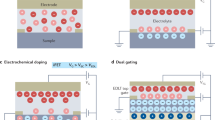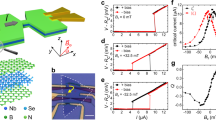Abstract
Electric field control of charge carrier density has long been a key technology to tune the physical properties of condensed matter, exploring the modern semiconductor industry. One of the big challenges is to increase the maximum attainable carrier density so that we can induce superconductivity in field-effect-transistor geometry. However, such experiments have so far been limited to modulation of the critical temperature in originally conducting samples because of dielectric breakdown1,2,3,4. Here we report electric-field-induced superconductivity in an insulator by using an electric-double-layer gating in an organic electrolyte5. Sheet carrier density was enhanced from zero to 1014 cm−2 by applying a gate voltage of up to 3.5 V to a pristine SrTiO3 single-crystal channel. A two-dimensional superconducting state emerged below a critical temperature of 0.4 K, comparable to the maximum value for chemically doped bulk crystals6, indicating this method as promising for searching for unprecedented superconducting states.
This is a preview of subscription content, access via your institution
Access options
Subscribe to this journal
Receive 12 print issues and online access
$259.00 per year
only $21.58 per issue
Buy this article
- Purchase on Springer Link
- Instant access to full article PDF
Prices may be subject to local taxes which are calculated during checkout




Similar content being viewed by others
References
Ahn, C. H. et al. Electrostatic modulation of superconductivity in ultrathin GdBa2Cu3O7−x films. Science 284, 1152–1155 (1999).
Ahn, C. H., Triscone, J.-M. & Mannhart, J. Electric field effect in correlated oxide systems. Nature 424, 1015–1018 (2003).
Takahashi, K. S. et al. Electrostatic modulation of the electronic properties of Nb-doped SrTiO3 superconducting films. Appl. Phys. Lett. 84, 1722–1724 (2004).
Takahashi, K. S. et al. Local switching of two-dimensional superconductivity using the ferroelectric field effect. Nature 441, 195–198 (2006).
Kötz, R. & Carlen, M. Principles and applications of electrochemical capacitors. Electrochim. Acta 45, 2483–2498 (2000).
Schooley, J. F. et al. Dependence of the superconducting transition temperature on carrier concentration in semiconducing SrTiO3 . Phys. Rev. Lett. 14, 305–307 (1965).
Ohno, H. et al. Electric-field control of ferromagnetism. Nature 408, 944–946 (2000).
Glover, R. E. & Sherrill, M. D. Changes in superconducting critical temperature produced by electrostatic charging. Phys. Rev. Lett. 5, 248–250 (1960).
Ueno, K. et al. Field-effect transistor on SrTiO3 with sputtered Al2O3 gate insulator. Appl. Phys. Lett. 83, 1755–1757 (2003).
Shibuya, K. et al. Field-effect modulation of the transport properties of nondoped SrTiO3 . Appl. Phys. Lett. 88, 212116 (2006).
Nakamura, H. et al. Low temperature metallic state induced by electrostatic carrier doping of SrTiO3 . Appl. Phys. Lett. 89, 133504 (2006).
Sato, T., Shibuya, K., Ohnishi, T., Nishio, K. & Lippmaa, M. Fabrication of SrTiO3 field effect transistors with SrTiO3−δ source and drain electrodes. Jpn. J. Appl. Phys. 46, L515–L518 (2007).
Dhoot, A. S. et al. Beyond the metal–insulator transition in polymer electrolyte gated polymer field-effect transistors. Proc. Natl Acad. Sci 103, 11834–11837 (2006).
Panzer, M. J. & Frisbie, C. D. High carrier density and metallic conductivity in poly(3-hexylthiophene) achieved by electrostatic charge injection. Adv. Funct. Mater. 16, 1051–1056 (2006).
Misra, R., McCarthy, M. & Hebard, A. F. Electric field gating with ionic liquids. Appl. Phys. Lett. 90, 052905 (2007).
Shimotani, H. et al. Insulator-to-metal transition in ZnO by electric double layer gating. Appl. Phys. Lett. 91, 082106 (2007).
Kawasaki, M. et al. Atomic control of the SrTiO3 crystal surface. Science 266, 1540–1542 (1994).
Tufte, O. N. & Chapman, P. W. Electron mobility in semiconducting strontium titanate. Phys. Rev. 155, 796–802 (1967).
Shimotani, H., Asanuma, H., Takeya, J. & Iwasa, Y. Electrolyte-gated charge accumulation in organic single crystals. Appl. Phys. Lett. 89, 203501 (2006).
Ohtomo, A. & Hwang, H. Y. A high-mobility electron gas at the LaAlO3/SrTiO3 heterointerface. Nature 427, 423–426 (2004).
Brinkman, A. et al. Magnetic effects at the interface between non-magnetic oxides. Nature Mater. 6, 493–496 (2007).
Reyren, N. et al. Superconducting interfaces between insulating oxides. Science 317, 1196–1199 (2007).
Ando, T., Fowler, A. B. & Stern, F. Electronic properties of two-dimensional systems. Rev. Mod. Phys. 54, 437–672 (1982).
Neville, R. C., Hoeneisen, B. & Mead, C. A. Permittivity of strontium titanate. J. Appl. Phys. 43, 2124–2131 (1972).
Mattheiss, L. F. Energy bands for KNiF3, SrTiO3, KMoO3, and KTaO3 . Phys. Rev. B. 6, 4718–4740 (1972).
Uwe, H., Yoshizaki, R., Sakudo, T., Izumi, A. & Uzumaki, T. Conduction band structure of SrTiO3 . Jpn. J. Appl. Phys. 24 (suppl. 24-2), 335–337 (1985).
Frederikse, H. P. R., Hosler, W. R., Thurber, W. R., Babiskin, J. & Siebenmann, P. G. Shubnikov–de Haas effect in SrTiO3 . Phys. Rev. 158, 775–778 (1967).
Herranz, G. et al. Full oxide heterostructure combining a high-TC diluted ferromagnet with a high-mobility conductor. Phys. Rev. B 73, 64403 (2006).
Acknowledgements
We thank S. Maekawa, M. Mori, N. Reyren, J.-M. Triscone and A. Tsukazaki for fruitful discussions.
Author information
Authors and Affiliations
Corresponding authors
Supplementary information
Supplementary Information
Supplementary Information (PDF 313 kb)
Rights and permissions
About this article
Cite this article
Ueno, K., Nakamura, S., Shimotani, H. et al. Electric-field-induced superconductivity in an insulator. Nature Mater 7, 855–858 (2008). https://doi.org/10.1038/nmat2298
Received:
Accepted:
Published:
Issue Date:
DOI: https://doi.org/10.1038/nmat2298
This article is cited by
-
Electrical switching of a bistable moiré superconductor
Nature Nanotechnology (2023)
-
Reversible metal-insulator transition in SrIrO3 ultrathin layers by field effect control of inversion symmetry breaking
Communications Materials (2023)
-
Tunable superconductivity and its origin at KTaO3 interfaces
Nature Communications (2023)
-
Realizing metallicity in Sr2IrO4 thin films by high-pressure oxygen annealing
NPG Asia Materials (2023)
-
Review of the role of ionic liquids in two-dimensional materials
Frontiers of Physics (2023)



